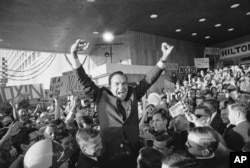In 1968, Richard Nixon accepted the Republican presidential nomination promising a war against crime.
Forty-eight years later, Donald Trump did the same thing as he accepted the Republican nomination Thursday.
“I have a message to every last person threatening the peace on our streets, and the safety of our police: When I take the oath of office next year, I will restore law and order to our country,” Trump said.
But there are limits to what a president can do to reduce crime. Unlike in some countries, most policing in the United States is done by agencies controlled by local governments, not the federal government.
“Federal law enforcement handles less than 10 percent of crime,” said Jack McDevitt, director of the Northeastern University Institute on Race and Justice.
Nixon and Trump paint scary picture
In his speech, Trump, like Nixon before him, painted a frightening picture of the crime threat facing America.
”Decades of progress made in bringing down crime are now being reversed by [the Obama] administration’s rollback of criminal enforcement,” Trump said. “Homicides last year increased by 17 percent in America’s 50 largest cities. That’s the largest increase in 25 years.”
Nixon talked about a “wave of crime” victimizing Americans.
The website Factcheck.org said Trump is correct to report an increase in homicide rates. However, it said that law enforcement experts say it is too early to say this is a trend. The website said crime rates are still far lower than in the 1990s.
Trump has not yet offered details on how a Trump administration would fight crime.
Bill Clinton’s anti-crime program
One of the largest federal anti-crime programs came from Democratic President Bill Clinton. He is the husband of current Democratic presidential candidate Hillary Clinton.
The 1994 crime bill that Clinton helped push through Congress increased penalties for federal crimes, especially drug violations. It also called for adding 100,000 new police officers with federal funds.
By 2005, a congressional report said the program had added 88,000 police officers. It found the program added about 1 percent to total local spending on police and “contributed to a 1.3 percent decline in the overall crime rate.”
Hillary Clinton has said adding police was a good thing. But, she said the bill went too far by requiring long sentences for non-violent drug offenses. She said it has led to the imprisonment of too many African-Americans.
Other similarities between Trump and Nixon
There are other similarities between what Nixon said in 1968 and what Trump said Thursday in Cleveland, Ohio, at the Republican National Convention.
Both men said their plans would help people of all races.
Nixon said: “And to those who say that law and order is the code word for racism, there and here is a reply: Our goal is justice for every American.”
Trump said: “Every action I take, I will ask myself: does this make life better for young Americans in Baltimore, Chicago, Detroit, Ferguson who have the same right to live out their dreams as any other child in America?”
The four cities he mentioned have a large population of African-Americans.
Racial tensions in the 1960s and Today
America struggled with racial tensions in the 1960s and still does today.
In the 1960s, there were race riots in some American cities. Some of the reasons were a lack of jobs, charges of violent police treatment of African-Americans and the assassination of civil rights leader, Martin Luther King Jr.
A 1968 report from the Kerner Commission said, “Our nation is moving toward two societies, one black, one white -- separate and unequal.”
In 2015 and 2016, the Black Lives Matter movement has protested police shootings of African-Americans. This month, there were killings of five police officers in Dallas, Texas, and three police officers in Baton Rouge, Louisiana.
Mass killings, connected to terrorism, in San Bernardino, California, in 2014, and last month in Orlando, Florida, have added to unease among Americans.
Bruce Alpert reported on this story for VOANews.com. Mario Ritter was the editor.
We want to hear from you. Write to us in the Comments Section and share your views on our Facebook Page.
_____________________________________________________________
Words in This Story
oath – n. an official promise by a person who has been elected to a public office to fulfill the duties according to the law
restore – v. to put or bring something back into existence or use
reverse – v. to change your decision or opinion about something
homicide – n. murder
trend – n. a general direction
officer – n. a member of a police force
decline – n. a reduction
society – n. people in a particular group









